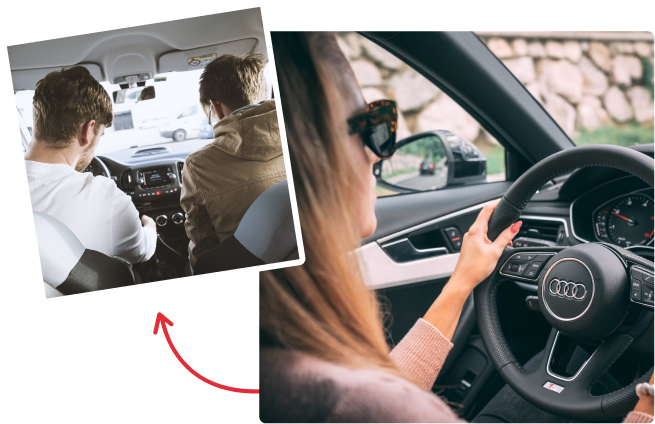Blind spots are a common yet often underestimated challenge for drivers. They significantly affect road safety and can lead to accidents if not managed properly. This blog post will cover everything you need to know about vehicle blind spots, their risks, and actionable tips to avoid them.q
What are driver blind spots?
A lot is said about driver blind spots, but very few actually know what they mean when they mention them. A blind spot, also known as a blind spot, is the places that limit the driver’s field of vision. From the driver’s seat, the view is restricted due to the parts of the car, and this situation creates zones of risk. Such zones have caused many accidents in recent years.
In addition, another thing to take into account is that rear-view mirrors also have blind spots. But why is this?
The blind spots in mirrors arise due to their size, the distance between the driver and the mirror, as well as the inflection of light as it is projected onto the mirror. A more experienced driver can anticipate these changes. However, for new drivers, the situation requires a lot of experience and specialized driving tutoring.
Common Causes of Blind Spots
- Vehicle Design: Thick A-pillars, large headrests, or small rear windows contribute to blind spots.
- Mirror Positioning: Incorrectly adjusted mirrors fail to provide optimal visibility.
- Driver’s Height: A driver’s seating position and height can also limit their view.
Risks of Blind Spots
Blind spots can lead to:
- Lane Change Accidents: Not spotting a vehicle in the adjacent lane.
- Pedestrian Collisions: Missing pedestrians walking near the car.
- Cyclist Hazards: Overlooking cyclists in narrow roads or intersections.
- Rear-End Crashes: Failing to notice a vehicle while reversing.
How to Deal with Blind Spots
Blind spots are unavoidable but manageable areas around your vehicle that limit your visibility. These unseen zones can obscure other vehicles, cyclists, or pedestrians, increasing the likelihood of accidents. Managing blind spots effectively is a crucial skill for safe driving and a key element in defensive driving practices.
By mastering blind spot techniques, you not only enhance your safety but also contribute to safer roads. If you’re interested in learning comprehensive defensive driving skills, GClass Driving School offers online courses to help you understand and apply these techniques effectively.
Let’s explore the essential strategies to adjust mirrors, optimize seating positions, and use technology to improve your visibility and driving safety.
1. Adjust Your Driver’s Seat
The right seating position is fundamental to minimizing blind spots. A properly adjusted seat provides a peripheral view of your surroundings, reducing the risk of accidents. Follow these guidelines to set your seat correctly:
- Ensure your left leg is slightly stretched when pressing the clutch pedal fully.
- Keep the seat 4–5 cm away from your head for comfort and safety.
- Align the headrest height with your eyes to prevent neck injuries.
- Maintain a backrest incline of 20–25 degrees for optimal posture and control.
2. Adjust Your Mirrors Correctly
Properly positioned mirrors significantly reduce blind spots. Incorrect settings can leave critical gaps in your visibility. Here’s how to adjust them effectively:
- Rearview Mirror: Align it to provide an unobstructed view of the road directly behind your car.
- Side Mirrors: Instead of tilting them to show your vehicle’s sides, adjust them outward so that only a small part of your car’s edge is visible. This minimizes overlap between your side and rearview mirrors, reducing blind spots.
Regularly check and fine-tune your mirrors during every drive for optimal road awareness.
3. Leverage Advanced Driver Assistance Systems (ADAS)
Modern vehicles come equipped with technology to assist in managing blind spots. These features enhance safety by providing real-time information about the areas surrounding your vehicle.
- Blind Spot Detection: Sensors monitor the sides of your car and alert you if another vehicle is in your blind spot. Visual indicators, like a light on the side mirror, and audible warnings help ensure safer lane changes.
- Lane Departure Warning: This system alerts you if your vehicle drifts out of its lane without signaling, reducing the risk of accidents caused by unintentional lane changes.
Although these systems are highly beneficial, always manually check your blind spots to supplement technology.
4. Utilize Backup Cameras
Backup cameras improve rear visibility, especially when reversing in tight spaces or crowded areas. These cameras clearly show obstacles, pedestrians, and other vehicles behind you.
Backup cameras:
- Enhance parking precision.
- Reduce the risk of collisions.
- Make reversing in driveways or parking lots safer and less stressful.
5. Stay Aware of Other Vehicles
Remember, all vehicles have blind spots. Avoid lingering in another driver’s blind spot, particularly near larger vehicles, such as trucks. Staying visible reduces the risk of accidents when other drivers make sudden maneuvers.
6. Execute Safe Lane Changes
Lane changes are a common source of blind spot-related accidents. To switch lanes safely:
- Signal Early: Use your turn signal to inform other drivers of your intention.
- Check Mirrors: Assess the traffic around you using your side and rearview mirrors.
- Look Over Your Shoulder: Perform a quick shoulder check to ensure no vehicles or obstacles are in your blind spot.
- Change Lanes Smoothly: Once it’s clear, transition steadily without abrupt movements or speed changes.
7. Merging with Caution
Merging into traffic, especially on highways, requires heightened attention. Follow these steps for a safe merge:
- Match Traffic Speed: Blend smoothly by adjusting your speed to match the flow of traffic.
- Monitor Surroundings: Use mirrors and shoulder checks to stay aware of nearby vehicles.
- Signal and Merge Gradually: Indicate your intention early and enter the lane with smooth, controlled movements.
By practicing these techniques, you minimize disruptions and avoid sudden braking or acceleration.
Why Choose GClass Drivers for Safe Driving Training?
At GClass Drivers, we are committed to providing comprehensive driving lessons that focus on safety and confidence. Our expert instructors emphasize crucial skills, such as managing blind spots, defensive driving techniques, and mastering road awareness.
Here’s why GClass Drivers is the perfect choice for your driving education:
- Learn from professionals who tailor lessons to your needs.
- Gain hands-on experience with practical techniques for real-world driving challenges.
- From blind spot checks to advanced road strategies, we ensure you’re equipped with the skills to drive safely and responsibly.
- Our lessons are designed to fit your busy lifestyle.
Ready to become a skilled and safe driver? Enroll in GClass Drivers today and let us guide you to success on the road. Contact us now to book your lessons and drive with confidence!





